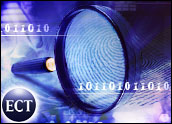
If one were to conduct a survey of technology publications over the past decade or so, it’s a good bet there would be at least one instance in each of those years in which someone declared that “this is the year of biometrics.”
Full of promise but long constrained by a diverse set of obstacles, biometrics — or the use of body or physical characteristics for secure authentication and identification — has not yet lived up to the hype.
Yet, lest we let 2007 slip by without the required declaration, let it be know that, indeed, this may well be the year biometrics takes hold on a broader scale, particularly its uses in security applications.
“This really is the year of biometrics,” Walter Hamilton, chairman of the International Biometric Industry Association, told TechNewsWorld. “There’s a lot of activity going on, and the market is beginning to see some widespread adoption that will actually touch consumers.”
Applications in Retail
For example, technology from Pay By Touch is being used in retail grocery chain Piggly Wiggly to allow customers to pay by simply providing their phone number and touching their finger to a fingerprint sensor. If the two match, it will automatically perform a transfer of funds to the merchant’s account using electronic check clearing.
The result? For the merchant, fewer fees to pay on credit and debit transactions, less need for managing cash and faster checkout lines. For the customer, quicker checkout, the ability to shop wallet- and PIN-free and what Hamilton calls “the benefit of anonymity,” which reduces the chances of identity theft by virtue of the fact that shoppers no longer have to present a card.
Three million customers have registered for the program, Hamilton said. “There are a lot of advantages. The primary ones are efficiencies of cost for the merchant and convenience for the consumer.”
Varying Attitudes
“Biometrics is a very sexy technology,” Ant Allan, research vice president for Gartner Group, told TechNewsWorld. “The challenge is having a workable, cost-effective system. The opportunity cost can be high, because money could always be spent on other, more proven technologies.”
Allan is skeptical that retail point-of-sale systems like Pay By Touch will achieve widespread adoption in the near future, largely because of consumer attitudes.
“Stores are thinking it makes customers move through faster, but the value proposition for customers is different, and not as convincing,” Allan explained. “The bottom line is, does it really enhance the customer experience enough to make them bother with it? Most folks are probably thinking, ‘I’m perfectly happy doing it the way I already do.'”
Differences in Culture
Interestingly, those consumer attitudes toward biometric technology seem to be very culturally based, with acceptance rates much higher in some countries than in others.
“There are more than 30 million users out there using our technology, but about half of those are outside the United States,” George Skaff, vice president of marketing for biometric vendor DigitalPersona, told TechNewsWorld. “In places like Latin America, Europe and Africa, people don’t have this notion of Big Brother watching” that Americans sometimes do, he said. “It’s just a convenience.”
DigitalPersona provides fingerprint technology for user authentication, and the technology is increasingly being built into notebook computers from Lenovo, Fujitsu, Toshiba and others. This is one of the fastest areas of uptake DigitalPersona sees, Skaff noted, because “fingerprint authentication is the most convenient way to replace a password for logging into computers, networks or Web sites.”
Concerns With Security
One thing users who are nervous about using fingerprint technology often don’t realize, he pointed out, is that once their fingerprint is scanned for use in such security applications, it is not saved. “We don’t keep the fingerprint image — just the data, which we use to construct an algorithm.”
There was also an early trend, Skaff explained, in which notebook manufacturers got “too enthusiastic” about what they could let users do with fingerprint technology, with the result that users got overwhelmed and confused. “In our current discussions, we’re trying to figure out which are the right applications to use the fingerprint readers,” he said.
Unlike DigitalPersona’s use of fingerprint scans, the U.S. government now uses them in such a way that fingerprint images are saved. Specifically, the Department of Homeland Security now requires that foreign visitors to the United States who arrive via air or sea have their fingerprints scanned for national security purposes, and when that is done, the fingerprint image is saved, Skaff said.
Banking Applications
Another consumer-facing application of biometrics currently in use today is in banking, as a replacement for PINs and ATM cards. In Korea, a number of banks are using fingerprints for these technologies, whereas in Japan, vein patterns seem to be preferred, Gartner’s Allan said.
Fingerprint sensors can be fooled, he explained — at least theoretically in test situations — but it’s near impossible to replicate the pattern of veins in an individual’s hand. In addition, vein readers are noncontact — that is, they work without requiring that the user touch them — which is particularly attractive in a country like Japan, Allan noted, where cultural attitudes often make people averse to touching things that have already been touched by others.
Other consumer uses of biometrics include biometrically enabled smartphones that serve as electronic wallets, smart door locks that require the right fingerprint before they’ll open and turnstyles at Walt Disney parks, Hamilton added, which now link tickets with ticketholders’ fingerprints to prevent fraud such as sharing of tickets.
In Nigeria, voters in this spring’s elections will be required to verify their identity by using their fingerprint. In preparation, some 10 million citizens are now having their fingerprints scanned, according to Skaff.
Enterprise Utilities
Enterprises are also increasingly making use of biometric technologies internally, particularly for access control. While Gartner currently estimates adoption is less than 20 percent of corporations worldwide, it predicts that in two to three years, that will increase closer to one third. Smart cards and one-time passwords, meanwhile, will reach about 50 percent adoption, Allan said.
One example on the enterprise side is the use of voice recognition for automatic telephone-based password reset systems, allowing corporate users to reset computer passwords without having to involve help desk staff.
Sensitivity of the voice recognition can be tuned, Allan noted, so that it minimizes user frustration while allowing the majority of calls to be handled automatically. For instances where the software can’t match the voice with the user, the call can automatically get forwarded to a live help desk staffer. “It’s easier for the user, and for the company,” Allan said. “It’s a natural fit.”
In the government, a personal identity verification system is currently being implemented that will require all federal workers and contractors who require unescorted access to present a smartcard with a chip on it that includes two fingerprints, Hamilton said. Once it’s in place, he estimates it will touch 6 million military staff and civilians.
A Final Caution
It’s a diverse area in which a number of widely varying vendors and technologies are all grouped under the umbrella term “biometrics,” and a frequent mistake is to assume they all involve similar pros and cons, Allan warned.
“This is often one of the things that really misleads some organizations,” he explained. “They see the successful use of biometrics in one application, and believe it should apply to another. We see organizations invest in one area because of a success in a noncomparable application, when in fact the same success criteria often don’t apply.”
Nevertheless, “the market is definitely picking up,” Hamilton said. “As the government implements more programs, people will become more comfortable and familiar with biometrics. It’s a pretty exciting time.”
This story was originally published on March 10, 2007, and is brought to you today as part of our Best of ECT News series.





















































